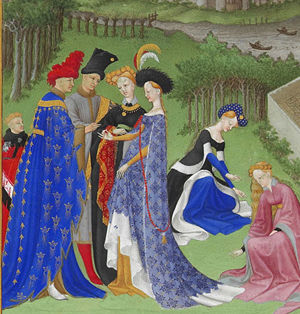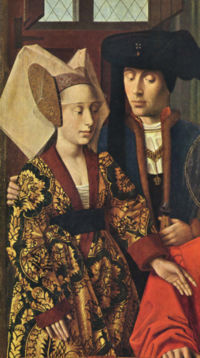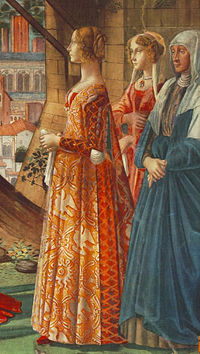
1400-1500 in fashion
Full-bodied houppelandes with voluminous sleeves worn with elaborate headdresses are characteristic of the earlier 15th century. Detail from Très Riches Heures du Duc de Berry.
Fashion in 15th century Europe was characterized by a series of extremes and extravagances, from the voluminous gowns called houppelandes with their sweeping floor-length sleeves to the revealing doublets and hose of Renaissance Italy. Hats, hoods, and other headdresses assumed increasing importance, and were swagged, draped, jewelled, and feathered.
Bold pomegranate- or artichoke-patterned silks are characteristic of the 15th century, as are richly coloured velvets and woolens. Fine linen was important for headdresses and for the shirts and chemises revealed by new lower necklines and slashing.
With England and France mired in the Hundred Years War and its aftermath and then the English Wars of the Roses through most of the century, European fashion north of the Alps was dominated by the glittering court of the Duchy of Burgundy, especially under the fashion-conscious power-broker Philip the Good (ruled 1419-1469). Having added Holland and Flanders to their dominion, the Dukes of Burgundy had access to the latest fabrics of Italy and the East and to English wool exports through the great trading cities of Bruges and Antwerp. Purchases of fabrics through Italian merchants like the two cousins Giovanni Arnolfini amounted to a noticeable proportion of all government expenditure. Especially in Florence, where sumptuary laws prevented the citizens from wearing the most luxurious cloths on which the city's fortunes were built, the materials of men's clothing in particular often appear plain in paintings, but contemporaries who understood the difference in grades of cloth very well would have appreciated the beauty and great expense of a very fine grade.
Fabrics and furs
Wool was the most popular fabric for all classes by far, followed by linen and hemp.[5] Wool fabrics were available in a wide range of qualities, from rough undyed cloth to fine, dense broadcloth with a velvety nap; high-value broadcloth was a backbone of the English economy and was exported throughout Europe.[6] Wool fabrics were dyed in rich colours, notably reds, greens, golds, and blues, although the actual blue colour achievable with dyeing with woad (and less frequently indigo) could not match the characteristic rich lapis lazuli pigment blues depicted in contemporary illuminated manuscripts such as the Très Riches Heures du duc de Berry.[5] Silk-weaving was well-established around the Mediterranean by the beginning of the century, and figured silks, often silk velvets with silver-gilt wefts, are increasingly seen in Italian dress and in the dress of the wealthy throughout Europe. Stately floral designs featuring a pomegranate or artichoke motif had reached Europe from China in the previous century and became a dominant design in the Ottoman silk-producing cities of Istanbul and Bursa, and spread to silk weavers in Florence, Genoa, Venice, Valencia and Seville in this period. [5] [7]
Fur was worn, mostly as a lining layer, by those who could afford it. The grey and white squirrel furs of the Middle Ages, vair and miniver, went out of style except at court, first for men and then for women; the new fashionable furs were dark brown sable and marten. Toward the end of the century, wild animal furs such as lynx became popular.[8] Ermine remained the prerogative and hallmark of royalty.
Slashing
Contemporary chroniclers identify the source of the fashion for slashing garments (to reveal a lining or full undergarment beneath) to the actions of Swiss soldiers in the aftermath of the Battle of Grandson in 1476.[9] Supposedly the Swiss plundered the rich fabrics of the Burgundian nobles and used the scraps to patch their tattered clothes. In reality, images appear of sleeves with a single slashed opening as early as mid-century, although the German fashion for "many small all-over slits" may have begun here.[10] Whatever its origin, the fad for multiple slashings spread to German Landsknechts and thence to France, Italy, and England, where it was to remain a potent current in fashionable attire into the mid-seventeenth century.
A second result of the defeat at Grandson was the decline of Burgundy as a fount of culture and fashion. The heiress Mary of Burgundy married Maximilian I, Holy Roman Emperor but died young. In the last decade of the century, Charles VIII of France invaded Italy and was briefly declared King of Naples. As a result, the French nobility were introduced to the fabrics and styles of Italy, which would combine with German influence to dominate fashion in France (and later, England) in the first half of the sixteenth century.[11]
Gown, kirtle, and chemiseFur-trimmed Burgundian gown of mid-century has a V-neck that displays the black kirtle and a band of the chemise. Hair is pulled back in an embroidered hennin and covered by a short veil.
Women's fashions of the fifteenth century consisted of a long gown, usually with sleeves, worn over a kirtle or undergown, with a linen chemise or smock worn next to the skin. The long-waisted silhouette of the previous period was replaced by a high-waisted style with fullness over the belly, often confined by a belt. The wide, shallow scooped neckline was replaced by a V-neck, often cut low enough to reveal the decorated front of the kirtle beneath.
Various styles of overgowns were worn. The cotehardie fitted smoothly from the shoulders to the hips and then flared by means of inserted triangular gores. It featured sleeves tight to the elbow with hanging streamers or tippets. The tight fit was achieved with lacing or buttons. This style faded rapidly from fashion in favor of the houppelande, a full robe with a high collar and wide sleeves that had become fashionable around 1380 and remained so to mid-century.[12] The later houppelande had sleeves that were snug at the wrist, making a full "bag" sleeve. The bag sleeve was sometimes slashed in the front to allow the lower arm to reach through.
Around 1450, the gown of northern Europe developed a low V-neck that showed a glimpse of the square-necked kirtle. The neckline could be filled in with a sheer linen partlet. Wide turn-backs like revers displayed a contrasting lining, frequently of fur or black velvet, and the sleeves might be cuffed to match. Sleeves were very long, covering half of the hand, and often highly decorated with embroidery. Fine sleeves were often transferred from one dress to another.
In Italy, the low scoop-neck of the early decades gave way to a neckline that was high in front with a lower V-neck at the back at mid-century. This was followed by a V-neckline that displayed the kirtle or gamurra (sometimes spelled camorra). Sleeveless overgowns were popular, and the gamurra sleeves displayed were often of rich figured silks. A sideless overgown called the giornea was also worn with the gamurra or kirtle. Toward the end of the period, sleeves were made in sections or panels and slashed, allowing the full chemise sleeves below to be pulled through in puffs along the arm, at the shoulder, and at the elbow. This was the beginning of the fashion for puffed and slashed sleeves that would last for two centuries.
The partlet, a sort of separate yoke to fill in a low neckline, appeared in this period, usually of sheer fabric (linen or possibly silk) with an open V-neckline. Burgundian partlets are usually depicted worn under the gown (but over the kirtle); in Italy the partlet seems to have been worn over the gown and could be pointed or cut straight across at the lower front.
Two uniquely Spanish fashions appear from the 1470s. The verdugada or verdugado was gown with a bell-shaped hoop skirt with visible casings stiffened with reeds, which would become the farthingale. The earliest depictions of this garment come from Catalonia, where it is worn with pieced or slashed sleeves and the second new style, a chemise with trumpet sleeves, open and very wide at the wrist.[1]
The sideless surcoat of the 14th century became fossilized as a ceremonial costume for royalty, usually with an ermine front panel (called a plackard or placket) and a mantle draped from the shoulders; it can be seen in variety of royal portraits and as "shorthand" to identify queens in illuminated manuscripts of the period.












No comments:
Post a Comment